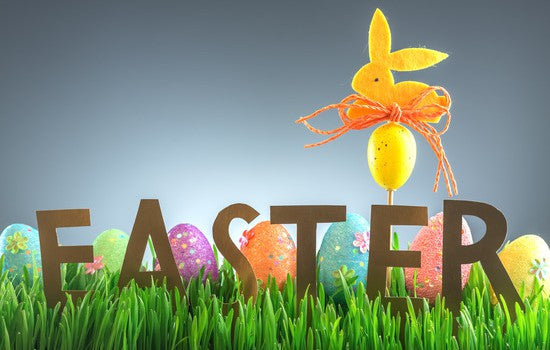
Article Detail
23 Mar
With Easter just around the corner, households across the country will be frantically searching for ways to make their living space a little more seasonally appropriate. Christmas decorations might involve a default set of standards to fall back on – you’re expected to secure a tree, some tinsel, some mistletoe and some additional decorative pieces to help tie the whole household together.
But no such standards exist for the other major Christian festival. Consequently, we’re required to exercise our creative faculties, and come up with some ingenious solutions. If you’re in search of inspiration for your Easter decorations, you’ve come to the right place – in this article we’ll explore just how you might transform your home into something fit for the season. Let’s begin, shall we?
Eggs
If there’s one item that’s symbolic of Easter time, it’s the egg. Eggs are forever wedded with the idea of new life, and so have been an enormously part of springtime folklore for millennia. While the obvious symbolic power of the egg might pre-date Christ, the idea of new life is heavily woven into the Christian story of Easter – and so it’ll little wonder that the egg has gone from strength to strength in Western Europe.
Egg-painting is one Easter tradition that’s perhaps not as widely-practised as once it was, but it’s a practice that’s still widespread in sections of continental Europe – notably Germany. It’s a tried-and-true method of injecting some colour into a home – while still keeping things appropriate to the season.

You might collect eggs throughout the year, paint them, and then incorporate them into a display. Painting eggs is a fun activity that both adults and children can involve themselves in. You can go as simplistic or elaborate as you like, and so there’s no excuse not to get yourself involved!
In order to be able to paint your eggs, you’ll need to ensure that they’re intact. But this needn’t meant that you should let your eggs go rotten. Next time you’re making scrambled eggs, just crack the bottom and let the egg fall out. That way, you’ll be able to stand them upright in a display. You might even arrange some twigs around the bottom in order to disguise the flat section at the bottom. If you feel like making an extra effort, you might even use a very fine drill bit in order to extract the middle of an egg – this way you’ll preserve the shape of the egg even after you’ve extracted its contents.
If you’d rather not go to the trouble of painting eggs for yourself, then you’ll be pleased to learn that there are plenty of egg-related decorative items ready-made. Designers across the world have tried to put a spin on the Easter egg theme, and so you have a huge range of items to choose from. You might consider, for example, the beautiful tin polka decorations from Gisela Graham, or this white hen egg keeper from the same designer, which will make a great statement in your kitchen once the season has been and gone. If you’re looking for something a little bit more central for your room, then Who’s it for? stock a stunning egg light shade from the Gisela Graham collection. the perfect addition for any home!
Rabbits

If eggs are the quintessential symbol of Easter, then rabbits must surely follow close behind in the hierarchy. Rabbits, being abundant during springtime, are closely wedded with spring festivals like Easter. Thanks to their famous ability to reproduce at an alarming rate, they’re symbolic of fertility and new life. At this time of year, rabbits are most often represented by the Easter Bunny, who delivered gifts to German children centuries ago, before eventually finding his way across the Atlantic. Rabbits have since become inextricable from Easter culture – they’re to be found on television screens and chocolate egg boxes across the land.
Rabbits should therefore play a part in any home decoration. But again, the precise form that such decoration should take has not yet been settled upon. You might make use of rabbit-shaped stencils and add a festive flourish to an available surface. If you feel like investing in some more permanent decorations, then you might instead elect to buy a wooden or metal rabbit to keep permanent watch over your living space. This woolly pink rabbit might just do the trick; it’s got an interesting two-dimensional aesthetic, while combining wood with wool – another material that’s emblematic of springtime. If you feel like the woolly pink rabbit just isn’t enough then don’t panic, Who’s it for? also have woolly pink chick, together they make the perfect pair.
Other traditions
Sweden is a nation that’s contributed a great deal toward home décor during Easter time. But perhaps the easiest such tradition to replicate involves decorated birch twigs. This tradition dates back to the sixteenth century, when swedes would whip one another with birch twigs in order to mark Shrove Tuesday and Good Friday, in order to remind themselves of the ordeal that Christ went through during his crucifixion.
Of course, no tradition involving whipping, however serious its origins, could survive long without children adopting it as a part of their playtime. Before long, it had become a family tradition, in which the first person to wake up in the morning could surprise the rest of the family with a good thrashing – which is not the most pleasant thing to wake up to on Good Friday morning.
A more pleasant tradition involves decorating birch twigs with coloured feathers. This is an easy tradition to adopt, as it can be done by anyone with the capacity to collect birch twigs and buy a suitable bunch of feathers. If you don’t want to have to do this yourself, you can always rely on ready-made birch decorations.
In the same vein you’ll find the Easter tree, which was thought up quite recently as an equivalent to the Christmas tree. Unlike its cousin, the Easter tree is a sparse, minimalistic thing made from birch branches. It’ll sit happily on any mantelpiece until the season is done with, when it can be easily stowed away until the following year.
 Free delivery on orders over £20
Free delivery on orders over £20






